TSA CBT Test: X-ray & ORT
Implemented in order to fight against air terrorism, X-ray screening is now one of the most important steps in airport security. X-ray technology allows a complete view of the interior of the luggage, allowing the contents to be inspected without opening it. Transportation Security Officers (TSOs) are the ones who look at and analyze the X-ray images of the luggage for any potentially dangerous objects. It is therefore logical that the TSA CBT Test includes an X-ray image analysis portion, as candidates must have a certain predisposition and ease in analyzing these images quickly and correctly. Indeed, a TSO Screener must be able to detect a threatening object in just a few seconds when inspecting an X-ray image of a passenger's baggage. This can be very complicated, given the many different shapes and materials that these objects can take on. In addition, these objects can look completely different in X-ray images than they do in real life, making the task of the Screeners even more difficult.
The TSA X-ray Test is known by many names, both past and recent. Examples include:
- TSA Object Recognition Test (TSA ORT)
- TSA X-ray ORT
- TSA Screening Test
- TSA X-ray Image Interpretation Test
- Pre-Board Screening Test
- X-ray Security Screening Test
- TSA CBT x ray practice test
- Airport Baggage Scanner Test
- Security X-ray Test
- Threat Image Projection Test
All these different names refer to the same test.
Test Format
| Test | TSA X-ray Test |
| Duration | About 30 minutes |
| Total number of questions | About 100 questions |
| Sections | 5/6 sections |
| Number of questions per section | 18 X-ray images to analyze |
| Time limit per question | 15 seconds |
| Introduction included | Yes |
| Type of questions | Two possible answers: 1 = presence of a dangerous object 2 = safe image |
| Complete preparation | Take a TSA practice test |
The TSA X-ray Screening Test is the second part of the TSA exam. It is divided into 5 to 6 sections, each lasting about 5 minutes. Each section has 18 X-ray images to be analyzed for a specific object to look for. It can be a knife, a gun or a grenade, or any other object considered dangerous and prohibited (more info here). For each image, you are given 15 seconds to determine if the object is there or not. You must then click on 1 if you think the object is there, or 2 if you think it is not (it can also be another number - you will receive a full explanation in the introduction to the exam). Before you begin the exam, you will be shown several images of different dangerous objects in the different forms in which they may appear in the X-ray images. You will have 30 seconds to memorize their shape, size, color, and positioning. This will be useful for the test itself and will give you a base to look for.
The entire X-ray test takes roughly 30 minutes for about one hundred questions, or roughly 5 minutes per section.
FAQ: X-ray Basics
What Are X-rays?
X-rays are waves of electromagnetic energy. These waves are part of the electromagnetic spectrum, which also includes radio, infrared, microwave, UV, and gamma waves. X-rays are about one thousand times shorter than the wavelength of light. They are a very penetrating form of radiation that can pass through various materials that are opaque to our eyes. The German scientist Wilhelm Conrad Röntgen discovered them in 1895 and received in 1901 the first ever Nobel Prize in Physics for this discovery.
The two most common commercial uses of X-ray technology are medical imaging and security screening of baggage and cargo. X-rays have particular advantages over other security technologies, which is why nowadays they are indispensable in all airports. Compared to metal detectors, for example, X-rays can not only facilitate the detection of conventional metal weapons such as guns and knives, but also high-tech plastic, composite and ceramic weapons, explosives, illegal drugs, and other prohibited items. In addition to detecting these objects, X-rays also allow us to perceive their exact size, shape, and location.
Limitations
Although X-ray technology is nowadays very advanced, analysis and decision making with regards to reliable threat detection still depends entirely on TSOs, who are trained to visualize and interpret X-ray images. Indeed, many elements can disturb the visualization of dangerous objects. For example, the position of the object in the luggage can greatly obstruct its detection, which is why screeners train themselves to detect weapons and suspicious objects from all possible angles. A gun seen from the side would be extremely easy to detect, whereas detection from above becomes much more complicated. In addition, nowadays many objects other than firearms and knives are prohibited, such as IEDs, razor blades and liquids, considered potentially dangerous by airports. The detection of objects of such different shapes and materials is much more complicated. The positioning of the bag itself in the X-ray machine can also affect the visualization of its contents.
Some materials, such as crystal or certain types of glass, used for example in camera lenses, cannot be penetrated by X-rays and therefore appear opaque (black) when passing through the X-ray machine. These materials can be used to hide dangerous objects, so it is important to know how to recognize these cases and to pass them to the screener in charge of inspecting the luggage manually.
There are many additional limitations to X-ray screening. This is why candidates wishing to become TSOs must have a basic knowledge of baggage screening when taking their CBT exams. They must also participate in numerous training courses once they become TSOs, as they guarantee the safety of airports, staff, and passengers.
Colors
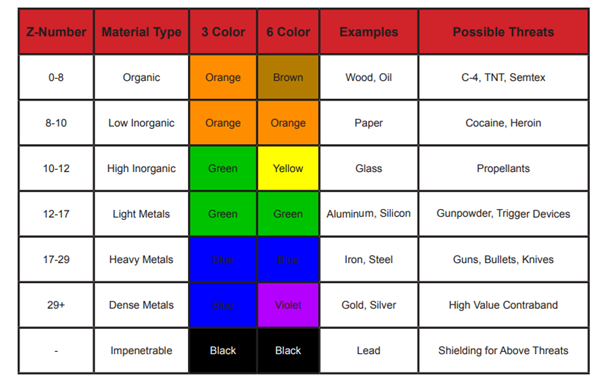
Before you can learn to decipher an X-ray image, you must understand the meaning of the colors. The colors are based on the average effective atomic number (Zeff) of each material. The three standard colors (orange, green and blue) are based on the periodic table. These colors allow us to differentiate between materials classified as "organic", "inorganic" and metals. The X-ray classification of these materials differs from the common definitions in chemistry, where an organic element is a material containing carbon (C). To an explosives expert, Ammonium Nitrate would be considered inorganic because its chemical formula does not contain carbon, whereas an X-ray system would classify it as organic because its effective atomic number is between 0-8. The explosive would therefore appear orange in the image.
The colors that appear on the screen when an object passes through an X-ray machine may differ depending on the machine used and its technological advancement. The depth of these colors is based on the difference in density between the varied materials; the denser the material, the darker it will be. The most common machines use three colors to show the differences between the materials present in the luggage and other scanned objects:
Orange
The color orange represents the least dense materials, most often organic materials, whose atomic number is between 0 and 8. These materials include wood, oil, leather, liquids, organic powders (flour, baking soda, yeast), gels, and rubber. Examples of potential terrorist threats that are made of organic materials and may appear orange in color include C-4 explosives, TNT or Semtex.
Historical fact: Semtex and TNT were used in the 1988 Lockerbie (Scotland) terrorist attacks that blew up a Pan Am Flight 103 plane, killing 270 people.
In 3-color X-ray systems, there is no difference between organic materials and "low inorganic" materials, which also appear orange and have an atomic number between 8 and 10. These materials can be, for instance, paper, different fabrics, or cardboard. However, they can also represent drugs such as cocaine or heroin, which are also represented in orange.
Example
This image includes two packages of cocaine hidden in the lining of the suitcase.
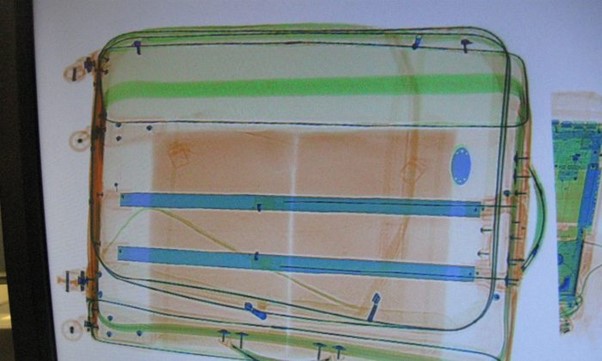
Green
The color green represents materials with atomic numbers between 10 and 17 (for 3-color systems), therefore including highly inorganic materials such as glass, porcelain, and ceramics, as well as light metals such as aluminum, silicone, and plastic. Examples of threats that can appear green are propellants, gunpowder, or trigger devices.
Example
Scan of black powder in a jar:
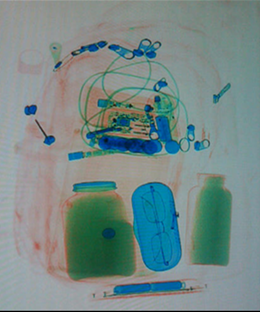
Historical Fact: In 2004, an inorganic explosive based on Potassium Chlorate (KClO3) was used to carry out a bombing at the Australian Embassy in Jakarta, Indonesia.
Blue
The color blue represents heavy materials (atomic numbers between 17 and 29) and dense materials (atomic number above 29). The intensity of the color blue increases with the density of materials. Among the heavy materials are iron and steel. Many threats appear in blue on the X-ray system screen, such as firearms and knives (conventional metal), batteries that can be connected to an explosive, grenades, bullets, etc. The densest materials include gold and silver, which can also be transported and can, in copious quantities, be connected to smuggling.
Example
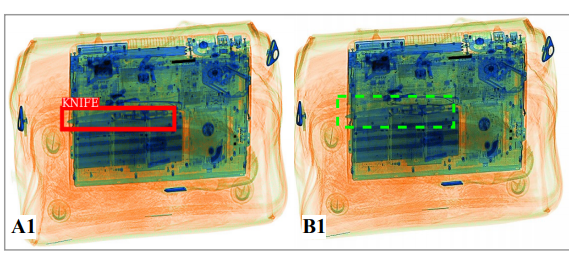
Historical fact: In the 09/11 attacks, the terrorists hijacked four planes with knives and cutters. It was only after these attacks that knives were banned on board aircraft.
Some newer X-ray devices can show six different colors on the screen, which makes it easier to distinguish between the different materials used:
- The color brown appears only when organic materials are present (Zeff = 0-8), thus making it possible to distinguish military explosives such as C-4, TNT, or Semtex, from other slightly inorganic materials which will appear orange, as in the three-color system. This reduces the number of false alarms during screenings.
- The color orange (Zeff = 8-10) also distinguishes drugs and fertilizers from other organic materials.
- The color yellow (Zeff = 10-12) appears only when glass is present. It allows the screener to identify bottles of alcohol or suspicious liquids.
- The color green (Zeff = 12-17) makes it possible to discern IEDs, composed of electronic circuits, and/or detonators.
- The color blue (Zeff = 17-29) is used to detect heavy metals such as iron or steel, i.e., the main components of firearms or knives.
- The color violet (Zeff = 29+) appears when dense metals are present; this includes precious materials such as gold, silver, or platinum. The separation into distinct colors of these materials helps to detect illegal trafficking of precious metals.
The color black, in both three and six color systems, appears when materials impenetrable by X-rays are present, such as crystal. These opaque materials can be used to hide dangerous or contraband objects in luggage.
In the CBT exam taken nowadays the X-ray images appear in three colors, as they are relevant in most airports. In the future, with the advancement of technology and the use of six-color X-ray machines, the CBT could also use these images to evaluate future TSOs in a context appropriate to the advancement of technology.
Tips and Tricks
- Concentration and speed are key in this test; you must stay focused because you have only 15 seconds per image. Thus, losing concentration will cause you to lose precious time that you need in order to determine whether or not an object is located in each given image.
- The objects appearing in the different categories may appear in different forms and may not necessarily correspond to the examples given at the beginning of each category. For example, the edged weapons may contain objects of all types, as explained earlier on this page.
- Angles and positions of objects in X-ray images may change, so it is important to look for objects in the image all the while keeping in mind that they may appear in different configurations.
- In some X-ray images, it may be difficult to distinguish the edges of different objects. In this case, focus on the colors and try to distinguish between the differences in intensity and shades.
- If you cannot find the object you are looking for in the image and you reach the time limit, we recommend that you choose to answer claiming that the object is not there and press "3", rather than not answering at all. This is because wrong answers do not take away points; you have nothing to lose by guessing. The time limit and stress may cause you to decide that an object is in a picture without having seen it. We recommend that you choose answer "1" only if you have successfully viewed the required object.
- To effectively scan for an object, divide the image into several parts. For example, you can divide the image into four parts (image a), divide it into several vertical parts (b) or horizontal parts (c) that you will study one by one. It is up to you to find the method that suits you best.
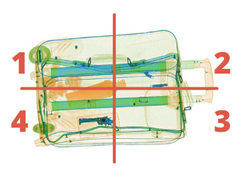
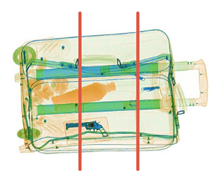
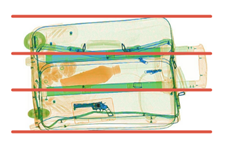
- Finally, the best advice we can give you is this: practice! Only 30% of the candidates who attempt the CBT X-ray test are successful, and this is largely dependent on their preparation. We have provided a complete guide to the different categories of objects that appear in the test. This page provides you with a lot of essential information to help you better understand the CBT X-ray test and we therefore recommend that you read the entire page and understand and memorize the different tips presented. For even more practice, visit the online preparation page, where you can practice questions similar to the test under the same conditions.
Read on: TSA CBT Test: X-ray Threat Categories & Free Tests
Did our tips help you pass the CBT test? Do you want to share your experience to encourage other candidates? We would greatly appreciate receiving any comments, testimonials, and experiences so that we can improve and help all CBT candidates succeed like you did.